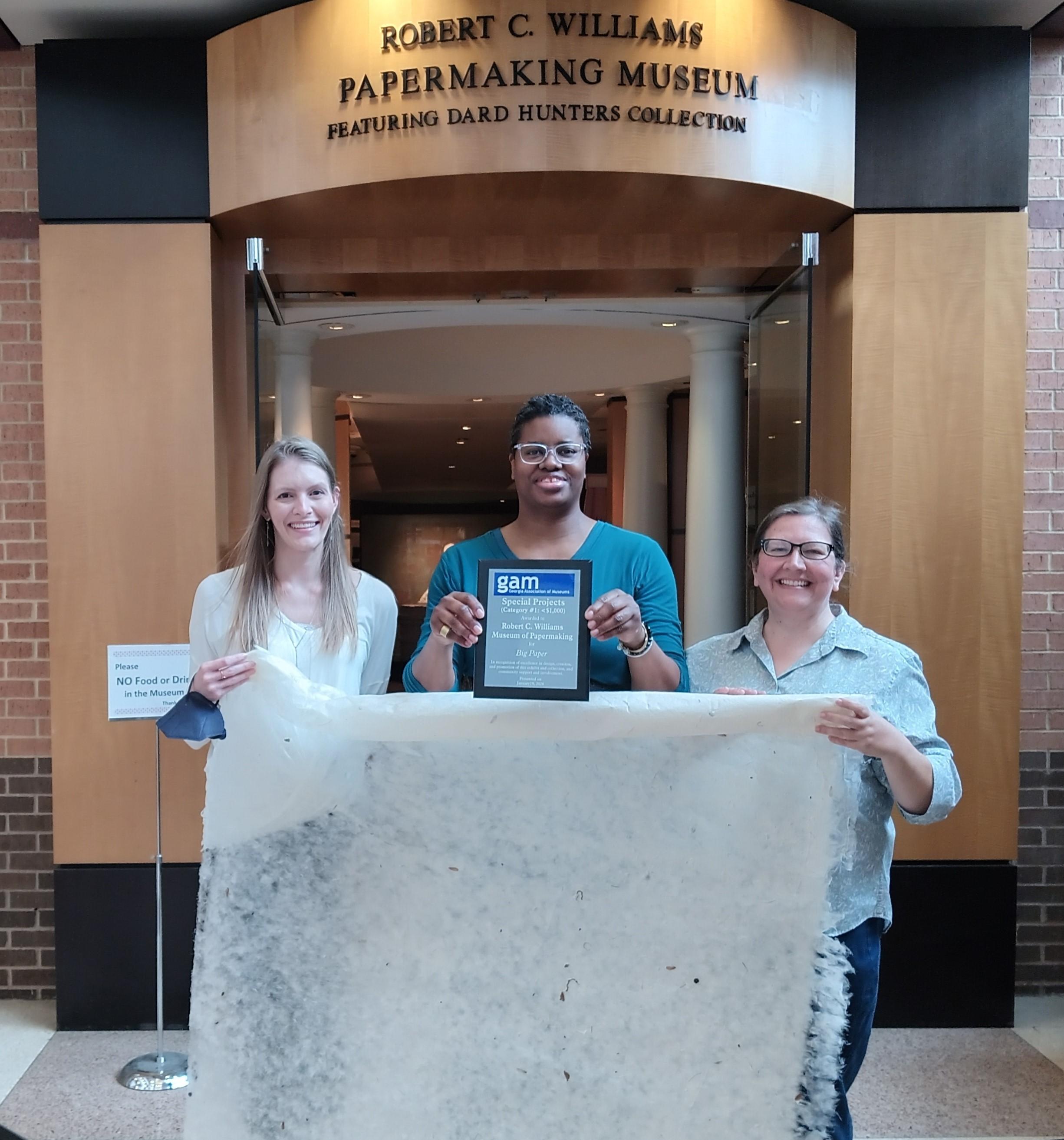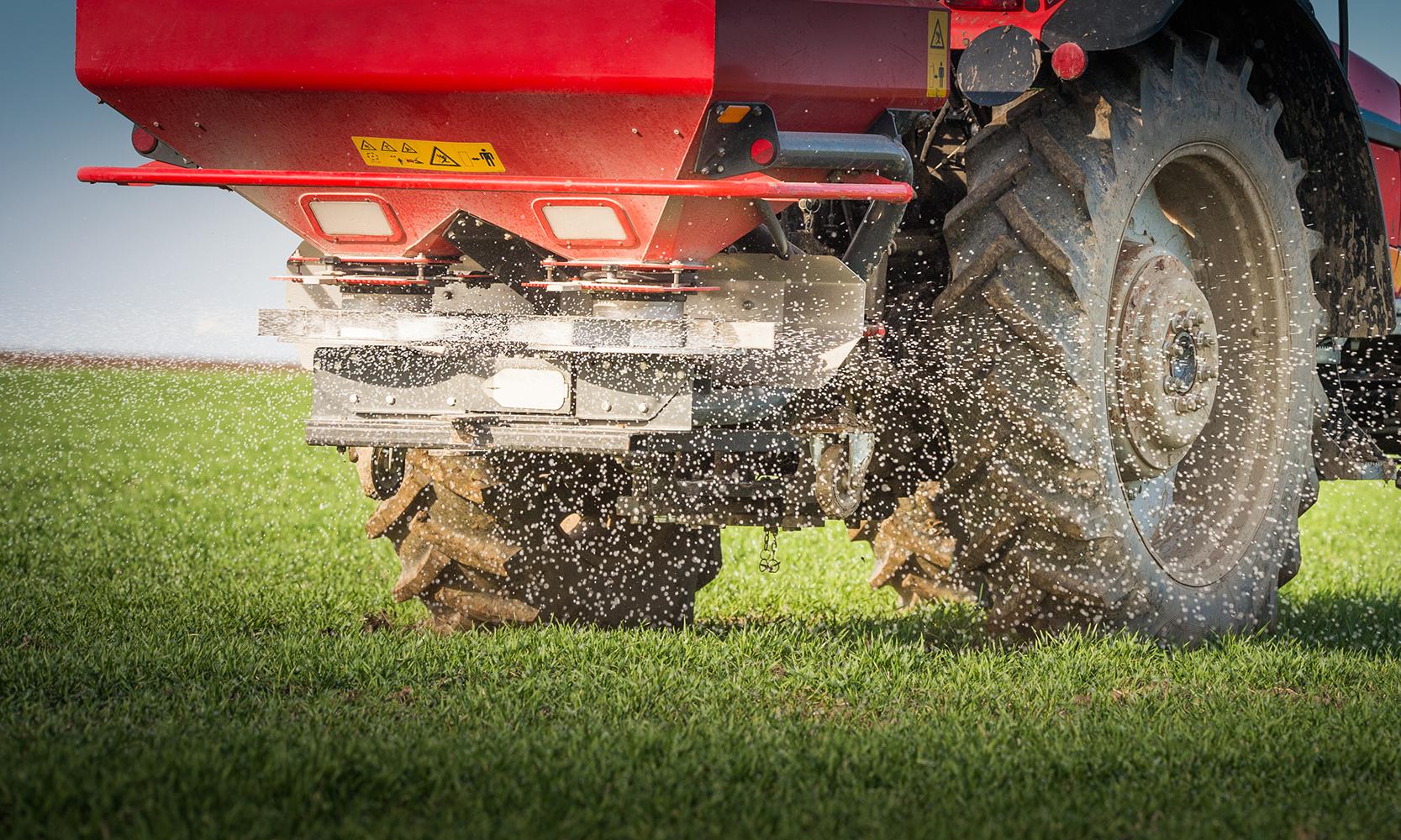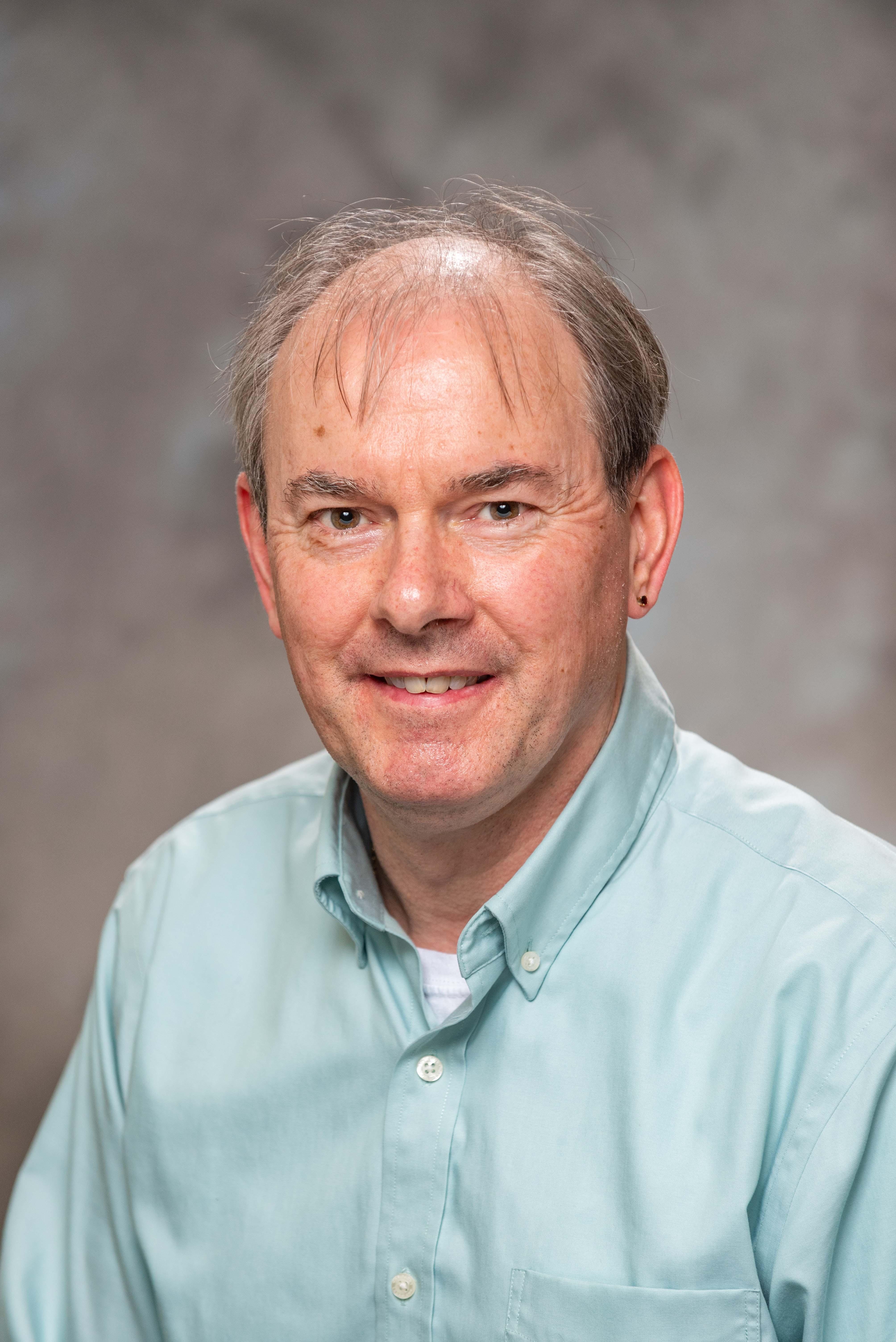Museum Receives Award
Feb 02, 2024 — Atlanta, GA

Museum staff Anna Doll, Jerushia Graham, and Virginia Howell pose with a large sheet of paper and an award from the Georgia Association of Museums for the project "Big Paper."
Over 200 museum professionals recently descended upon Athens, Georgia, for the annual meeting of the Georgia Association of Museums (GAM). They arrived from all regions of the state, from Rome to Thomasville to Savannah. The theme of the 2024 conference was “Finding the Right Frequency: Museums and Communities in Harmony.” Attendees participated in a variety of sessions and workshops ranging from developing education programs to designing eye-catching exhibits and visiting with vendors whose products and services target the field. Many Athens-Clarke County museums and cultural institutions opened their doors to attendees for tours and events. The highlight of the week was the annual GAM Awards Luncheon.
This year the Robert C. Williams Museum of Papermaking was presented the Special Project (under $1,000) award by GAM President Marcy Breffle and Award Committee Co-Chairs Melissa Swindell and Karin Dalton for the project “Big Paper.” “We are very pleased to present this award to a very deserving recipient,” said GAM President Breffle. “Our members represent a good cross section of museums and cultural organizations in Georgia’s communities, large and small,” she added. “We are happy to honor institutions, staff members, volunteers, patrons, exhibits, and special projects that have excelled in providing inspiring programs and leadership,” she concluded.
Under the guidance of museum staff Jerushia Graham and Anna Doll, “Big Paper” is a project in which groups from nearby colleges and universities experience making large sheets of paper – 4’ x 6’—in a communal setting. From preparing fiber by hand beating plant material to working together to fill a papermaking mold, students worked together to create something huge! The inaugural event was in April, 2023, and had participants from the University of Georgia, Spelman College, Kennesaw State University, and the Georgia State University Art Club. The event returns in 2024 with noted papermaker Tom Balbo, founding director of the Morgan Conservatory, leading the communal event.
Museum Director Virginia Howell says, “The Paper Museum is honored to receive this award. It is a testament to the hard work of the museum team, and the project has allowed us to build on relationships with so many people who are interested in learning more about the papermaking process and how it can be an incredibly fun yet challenging experience.”
Big Paper returns on April 13, 2024.
Virginia Howell
virginia.howell@rbi.gatech.edu
404-894-5726
Paper Museum Employee Shares Talents With Atlanta
Jan 30, 2024 — Atlanta, GA
Jerushia Graham, museum coordinator for the Robert C. Williams Museum of Papermaking, in front of her digital billboard honoring the unofficial "mayor" of Auburn Avenue John Wesley Dobbs. (Photo by Allison Carter)
Georgia Tech employees, like Jerushia Graham, often contribute their time and talents to the greater Atlanta community. Graham, museum coordinator for the Robert C. Williams Museum of Papermaking, recently created a digital billboard as part of Local Stories, an initiative that presents lesser-known facts about downtown Atlanta’s rich history.
Graham’s work honors the leadership and legacy of John Wesley Dobbs, a political activist and the unofficial “mayor” of Atlanta’s Auburn Avenue during the first half of the 20th century, through papercutting and animation.
“The graphic quality of papercuts requires a whittling down of visual information to the essential details,” she said. “After careful consideration, I settled on directing the viewer’s attention to Dobbs’ role in mobilizing the Black vote because his voter registration efforts made concrete and lasting changes.”
Graham’s digital billboard, entitled LEGACY: John Wesley Dobbs, is reminiscent of vintage postcards and posters. The design choice is an intentional nod by Graham to Dobbs’ many years of service as a postal officer. The U.S. Postal Service, one of the few institutions in the U.S. with an integrated workforce at the time, was arguably one of the largest employers of African Americans. Dobbs would ultimately be promoted to a supervisory role over both Black and white employees.
“Although LEGACY is technically a digital billboard, I personally think of it as a postcard from me to each and every viewer reminding them and myself that our lives leave an impact,” Graham said. “I ask that we invest in one another, engage with the history of Atlanta, and participate in the decisions that govern our lives by voting.”
Local Stories are displayed monthly on the digital sign at Margaret Mitchell Square (140 Peachtree St. NW).
Institute Communications
Marta Hatzell Wins ACS Sustainable Chemistry & Engineering Lectureship Award
Jan 26, 2024 — Atlanta, GA

Associate Professor Marta Hatzell has won a 2024 ACS Sustainable Chemistry & Engineering Lectureship Award, which recognizes leading contributions of scientists and engineers active in the general fields of green chemistry, green engineering, and sustainability in the broadest sense of the chemical enterprise.
Hatzell, who holds joint appointments in Georgia Tech's School of Mechanical Engineering and School of Chemical and Biomolecular Engineering, was honored for her multiple contributions that drive the application of electrochemistry to enable critical systems with enhanced circularity.
The ACS Sustainable Chemistry & Engineering Lectureship awards were created to celebrate early to midcareer investigators who completed academic training no more than 10 years prior to nomination. In support of their commitment to nurture and stimulate a global community of outstanding practice. ACS Sustainable Chemistry & Engineering and the ACS Green Chemistry Institute gave three Lectureship Awards to recognize outstanding levels of contribution from The Americas, Europe/Middle East/Africa, and Asia/Pacific.
The award recipients will be honored at a joint plenary session of the 28th Annual Green Chemistry & Engineering Conference in their honor (June 3–5, 2024; https://www.gcande.org/).
Brad Dixon, Communications Manager, School of Chemical and Biomolecular Engineering
Science and Engineering Day at Georgia Tech
Members of the Georgia Tech community are opening their doors once again as part of the 11th annual Atlanta Science Festival. This year, Science and Engineering Day at Georgia Tech will serve as the kickoff event for the entire festival!
Seminar on Polyolefin Circularity: Better Measurements and Data to Enable Change
Seminar Topic: Polyolefin Circularity: Better Measurements and Data to Enable Change
Speaker: Dr. Kate Beers
Senior research scientist at National Institute of Standards and Technology
Date and Time: Monday, January 22th, 2024 , 3:30-4:30 P.M.
Venue: College of Computing, Room 16
Faculty Host: Dr. Blair Brettmann
Museum Exhibit: Sustainability in Chaos
Jurors Helen Hiebert and Eileen Wallace invited twenty-nine paper artists to demonstrate their insights as artists in the chaos of today's life and how they transform chaos into a vision of what is possible. Through the medium of paper with its boundless style, sustainability, and conceptual framework, the featured artists share their responses to chaos and demonstrate how the arts and sustainability can elevate inspiration and leave a lasting impression on communities.
Photochemistry and a New Catalyst Could Make Fertilizer More Sustainable
Dec 22, 2023 — Atlanta, GA

Georgia Tech engineers are working to make fertilizer more sustainable — from production to productive reuse of the runoff after application — and a pair of new studies is offering promising avenues at both ends of the process.
In one paper, researchers have unraveled how nitrogen, water, carbon, and light can interact with a catalyst to produce ammonia at ambient temperature and pressure, a much less energy-intensive approach than current practice. The second paper describes a stable catalyst able to convert waste fertilizer back into nonpolluting nitrogen that could one day be used to make new fertilizer.
Significant work remains on both processes, but the senior author on the papers, Marta Hatzell, said they’re a step toward a more sustainable cycle that still meets the needs of a growing worldwide population.
“We often think it would be nice not to have to use synthetic fertilizers for agriculture, but that’s not realistic in the near term considering how much plant growth is dependent on synthetic fertilizers and how much food the world’s population needs,” said Hatzell, associate professor in the George W. Woodruff School of Mechanical Engineering. “The idea is that maybe one day you could manufacture, capture, and recycle fertilizer on site."
Joshua Stewart
College of Engineering
Why Your Scissors Glide (or Don't) When You're Wrapping Presents
Dec 21, 2023 — Atlanta, GA

Wrapping Presents
In the hustle and bustle of the holidays, a moment of transcendence can happen as you wrap presents: scissors in hand, cutting a piece of wrapping paper from the roll, the blades hit their stride and slide from end to end.
Why is it sometimes the scissors glide, and other times the paper tears a dozen times? Christopher Luettgen says it all has to do with paper quality.
“Good wrapping paper is going to have a prettier surface. It may even have a textured surface, maybe embossed or more three dimensional,” said Luettgen, a professor of the practice with the Renewable Bioproducts Institute and an expert on paper.
High-quality wrapping paper is made from softwood pulp — in particular, the strongest pulp you could make is southern pine softwood.
“The really good paper starts with softwood fiber,” he said. “Softwood kraft in particular — ‘kraft’ being an old German word for ‘strong.’ It’s going to be stiffer and stronger in multiple directions. Then it gets coated so you get a nice clay coating on the surface, which will smooth the surface to get it beautifully printed. When you come across weak paper that wants to tear very easily, it is often made with mechanical fibers.”
So, if you want the glide, you want good paper. When might it be worth skimping on quality?
“If you’ve got a big job, like you want to wrap a TV or a large game or something like that, you don’t want to spend a lot of money on the high-end wrapping papers. It’s going to get torn up pretty fast. That’s when you might go with a cheaper, thinner brand.”
Of course, as Luettgen notes, you can’t tear the paper in the store, but looking for a thicker paper is a good start. The thicker paper will also give your presents a more refined look under the tree.
“Let’s say you’re giving a book to somebody. You want nice tight corners. You want good creasing. You really want to make it showy.”
Why, then, does Santa sometimes not wrap his presents? Luettgen believes it’s all a matter of resources leading up to Christmas Eve.
“If he has enough help at his studio, I would think that he’s going to get all of your presents wrapped. But if he’s rushed, with bad weather for instance, he may have to come down the chimney with the presents unwrapped, but they’ll be under the tree.”
Institute Communications
Seminar - Department of Energy Zero Carbon Energy: Progress to Net Zero
Join us on January 17th at 9am at 1128 Petit Institute for Bioscience and Bioengineering (IBB) for a seminar on "Department of Energy Zero Carbon Energy: Progress to Net Zero" by John
SEI/RBI Initiative Lead Profile: Matthew Realff
Dec 13, 2023 — Atlanta, GA

Portrait of Matthew Realff
Matthew Realff, professor and David Wang Sr. Fellow in the School of Chemical and Biomolecular Engineering, leads the Circular Carbon Economy Research Initiative in the Strategic Energy Institute and the Next Generation Refineries Research Initiative in the Renewable Bioproducts Institute at Georgia Tech. Realff co-directs the Direct Air Capture Center (DirACC), which coordinates research across the Institute aimed at the removal of carbon dioxide (CO2) from the atmosphere. Realff’s broad research interests are in the areas of process design, simulation, and scheduling. His current research is focused on the design and operation of processes that minimize waste production by recovery of useful products from waste streams, and the design of processes based on biomass inputs. In particular, he is interested in carbon capture processes both from flue gas and dilute capture from air as well as the analysis and design of processes that use biomass. Below is a brief Q&A with Realff where he discusses his research focus areas and how it influences the circular carbon economy research initiatives at Georgia Tech.
- What is your field of expertise and at what point in your life did you first become interested in this area?
My background is in chemical engineering with a focus on process design and simulation, which is part of the field of process systems engineering. I have been interested in this general topic since first setting foot on the campus of Imperial College London in 1982, and subsequently pursued it as my Ph.D. topic. I first started thinking about direct air capture of CO2 in 2011 and about circular carbon from CO2 in 2016.
- What questions or challenges sparked your current energy research? What are the big issues facing your research area right now?
I believe that managing CO2 emissions will be the biggest challenge of the next 50 to 100 years. We will need to have negative emissions, as we are emitting too much, and pulling CO2 directly out of the atmosphere will be required because we are going to continue to emit. Creating technological solutions to provide negative emissions is one of the biggest challenges, as they need to be cost-effective and environmentally and socially less damaging than the emissions they capture. The biggest issue facing my research is understanding the phenomena that are involved in direct air capture and translating that understanding into engineered systems that are low-cost, have low environmental impact, and are socially beneficial.
- What interests you the most leading the research initiative on circular carbon economy? Why is your initiative important to the development of Georgia Tech’s energy research strategy?
The circular carbon economy is a systems problem in the broadest sense. This means that we must embrace a multidisciplinary approach to synthesize effective solutions. I want to emphasize the word “effective” here — we must embrace a wide range of measures of performance from energy efficiency to social justice because without improving along many dimensions we will be unlikely to be successful. It is this multidimensional, multidisciplinary research effort that interests me, as I love to find ways to bring people together to synthesize different knowledge into effective solutions. Georgia Tech is a world leader in direct air capture technology — as demonstrated by our new Direct Air Capture Center (DirACC). Our advances in this topic area can provide a base from which to develop approaches to carbon utilization, and other research efforts in electro, bio, and thermo chemical technologies can enable closed pathways using carbon as an energy carrier.
- What are the broader global and social benefits of the research you and your team conduct on circular carbon economy?
One vision for our energy and material systems is to have a much greater local production and consumption of energy using renewable resources. A circular carbon economy based on CO2 from the air; water from local sources including the air; and solar, wind, or biomass-based energy could be local and would have many transactions between local parties. This could serve to not only reduce global emissions but also to provide more opportunities for communities to benefit from the production of energy as opposed to having many transactions that transfer money outside of the community.
- What are your plans for engaging a wider Georgia Tech faculty pool with the broader energy community?
DirACC is one way we hope to connect faculty to the ecosystem of companies that are developing and deploying DAC technology. We hope that the challenges that these companies are articulating can be translated into research topics for the faculty affiliated with the center. The Department of Energy’s efforts to establish the DAC Hubs provides us with other opportunities to engage faculty around social and environmental justice issues associated with deploying energy technologies such as direct air capture. I hope that faculty will see themselves participating in these efforts and reach out to be included in the network of researchers on these topics.
- What are your hobbies?
My main hobby is playing a card game called Magic: The Gathering. I have played this since 1994 and have enjoyed many friendships formed as a dueling wizard. I also enjoy reading, particularly science fiction and steampunk literature, as well as history.
- Who has influenced you the most?
Professor Roger Sargent at Imperial College was one of the founders of the field of process systems engineering. His speech on elevation to the position of professor at Imperial in 1963 has had a profound impact on the direction of my research and educational activities.
Priya Devarajan || Research Communications Program Manager SEI || RBI
